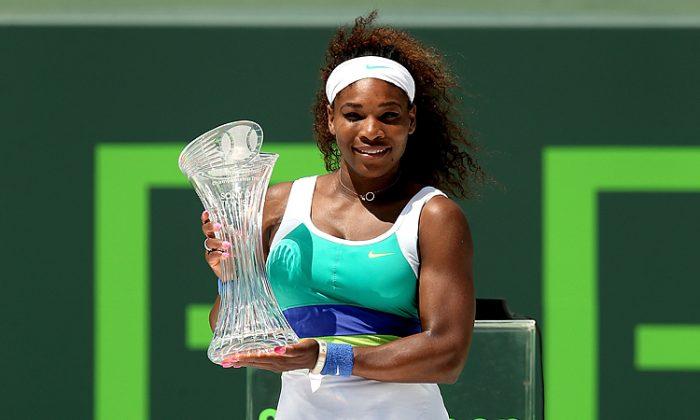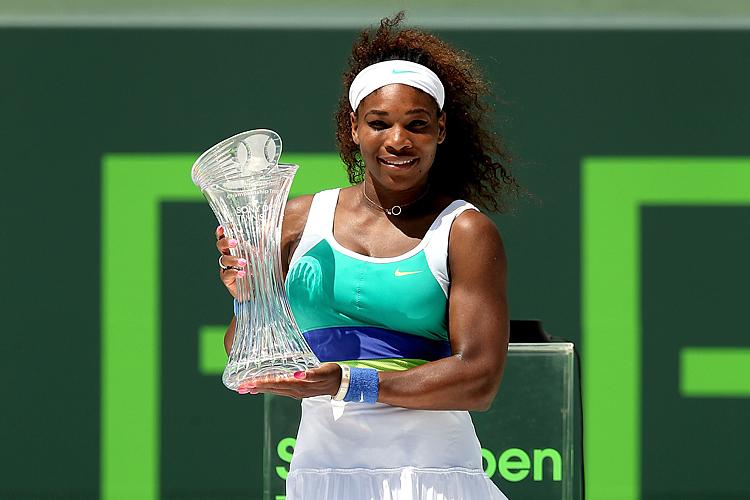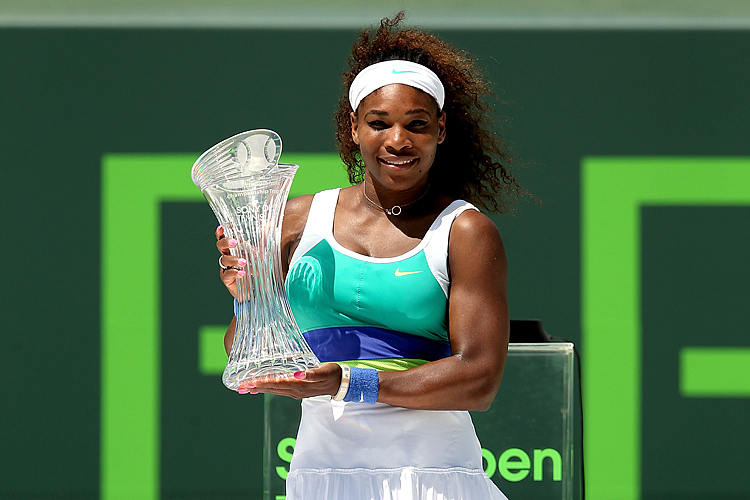World number-one-ranked Serena Williams faced off against number-two Maria Sharapova at Miami’s Crandon Park at the ATP Sony Open tennis tournament, offering fans three sets of women’s tennis at its highest level.
After dropping the first set and battling back in the second, Serena Williams steamrollered Sharapova in the third, but for almost the entire first two sets, the match could have gone either way.
Williams’ sixth Sony Open win set a record for women’s tennis, and extended her 11-match winning streak over Sharapova.
“It feels really good. In the beginning of the week or start of the tournament, I definitely didn’t feel like I would be here, not with the way I was playing. But, you know, it definitely feels good to go through everything,” Williams told the post-match press conference, according to sonyopentennis.com.
Despite her record-setting win, Williams was very critical of her play. “I feel like I was just making so many errors, and I just was like, ‘Serena, are you really going to get to the final and not play up to your potential?’
“I don’t think I was as energized as I could be. I think I may have done too much work yesterday, may have hit too long, done too much gym. At one point, I was just like, ‘Conserve your energy and try and relax and play better.’”
Despite serving six aces, Serena admitted her service game was off all through the tournament. “I honestly have not served great this whole tournament,” she said. “Usually in the later rounds I’m able to pick it up and able to do a little better. Unfortunately, I wasn’t able to do that today, so I had to rely on other parts of my game.” Fortunately, the rest of her game is strong enough to beat the second-ranked player in the world.
Playing the improved Maria Sharapova might have been the spark which pushed Williams to overcome her troubles.
“I like to play anyone that’s a top player,” Serena explained. “As you can see today, I feel like she lifted her level, and any player makes me have to lift my level and be like, ‘Okay, what can I do to win this? What can I do to get better? Can I get better?’
“For me that answer is always yes and figuring out how to do it. It’s not just her. It’s anyone that’s a top player. I just feel like I want to do the best that I can.”
The match offered the best women’s tennis has to offer: its top two practitioners, in good health, in the final of one of the most important matches outside the Grand Slams, a tournament each wanted very much to win for different reasons.
Maria Sharapova had spent the off-season working on her movement, her foot work, and her forehand—the only weaknesses in her game—and the results were immediately obvious. Serena Williams was reasonably healthy for the first tournament all year—though she had had minor pains from her hip flexor muscles early in the tournament, her movement was unimpeded during Saturday’s final.
Sharapova was playing to win her first Sony Open in five trips to the finals. She was also trying to end a 13-set, 10-match losing streak to Williams, and to increase her end of the 11–2 edge Williams held in matches in their history. At 25, Sharapova had come back from surgery to rebuild he reputation as one of the top women tennis players in the world; her bête noir would be facing he on Saturday.
Williams was looking at breaking a tie with Steffi Graf as five-time winners of the Sony Open, and tying instead with André Agassi at six. The 31-year-old was also coming back from time off from injuries, and in fact had still been hindered by ankle, back and now hip ailments all year.
Both players were eager to win the match, to overcome their pasts and start better futures, and their intensity showed from the opening games.
The third game of the first set revealed the nature of the competition: the fourteen-minute contest went to Deuce eight times before Williams managed to hold serve on a pair of Sharapova errors.
For years the book on Sharapova was that she went all-out on every serve but wasn’t the best mover, and her forehand was suspect. This game showed that the Russian native had erased those weaknesses; she gave Serena all she could handle from the service line from the baseline, and on the run, targeting Serena’s forehand successfully in the first set—Williams hit twice as many errors as winners from this side in the first set.
While Williams was struggling to hold serve, Sharapova breezed through her first few service games losing but a point in each. She took advantage of Serena’s errors to break her serve in the fifth game of the match—at this point Sharapova was serving at 85 percent and Williamas, 58.
The break seemed to infuriate Williams; she fought back to break back in the next game. Williams’ anger wasn’t enough to keep he shots inbounds, though, and she was broken again on a double fault in the ninth game of the set.
Sharapova won the set in the next game, ending her 13-set losing streak to Williams and surely giving the young number-two player confidence for the second set.
The loss did something else entirely for Williams—it infuriated her and focused her. Shara pova was playing superb tennis—perhaps the best of her career—but Serena Williams found another elvel in her own play.
Williams blasted her way thought he first game of the second set at love, riding her powerful, accurate serve to victory, then broke Sharapova in the second game, taking advantage of errors.
Sharapova broke right back in the next game as Serena hit several balls awry, then held in game four. At this point the match was entirely mental; whichever player could sustain the tighter focus for longer would win the points, the set, and the match.
Sharapova showcased her newfound ability to hit on the run in the next game, winning some tough points early then riding Serena’s errors to yet another service break. Again Serena dug deep and came up with a little more, getting the break back with some big forehand winners. Apparently Serena had found the range with that shot, but Sharapova kept targeting it, which strategy did not serve her well.
Willimas held serve in game seven, a game which saw both players make amazing shots. Sharapova came back strong in her service game, taking the score to 40–15 before Serena dug in and fought back, taking the game to deuce twice. Here Sharapova lost focus; she hit a double fault, and then netted a shot, giving Serena yet another service break and the chance to serve out the set.
This wasn’t easy; Sharapova went up 30–0 before Serena settled down and with a 120-mph ace and an Sharapova error, took the set.
Maria Sharapova had played tremendous tennis, often better than number-one-ranked Serena Williams, through most of the first two sets. She lost all that in the final set.
Sharapova opened serve, still aiming at Williams’ forehand, but Serena had turned that deficit into an asset, pounding winners and breaking serve. Sharapova didn’t seem to know what to do, and her confusion showed in shorter shots, which gave the powerful Williams an unconquerable edge.
Williams kept hitting forehand winners, backhand winners, great shots from everywhere, while Sharapova lacked power. A double fault led to another service break, and more errors and more short shots returned for winners led to yeat nother break of serve.
Serena stepped up to the line in the sixth game having won nine straight and serving for the match. She smacked an ace, but followed it up with a double fault. A couple more misses from Serena tied the game at 30 and Sharapovova fought hard for the next point, only to net a shot after a long rally.
Williams stamped the game set and match as hers with a final ace, finalizing her triumph and earing her record sixth win.
Sharapova, for all her hard work, lacked just a little to handle Serena Williams at her best, but the young number two played excellent tennis and gave every fan courtside or watching on TV a tremendous show—and gave Serena a bit of scare early on.
2013 looks to be an intense and exciting year in women’s tennis.








Friends Read Free